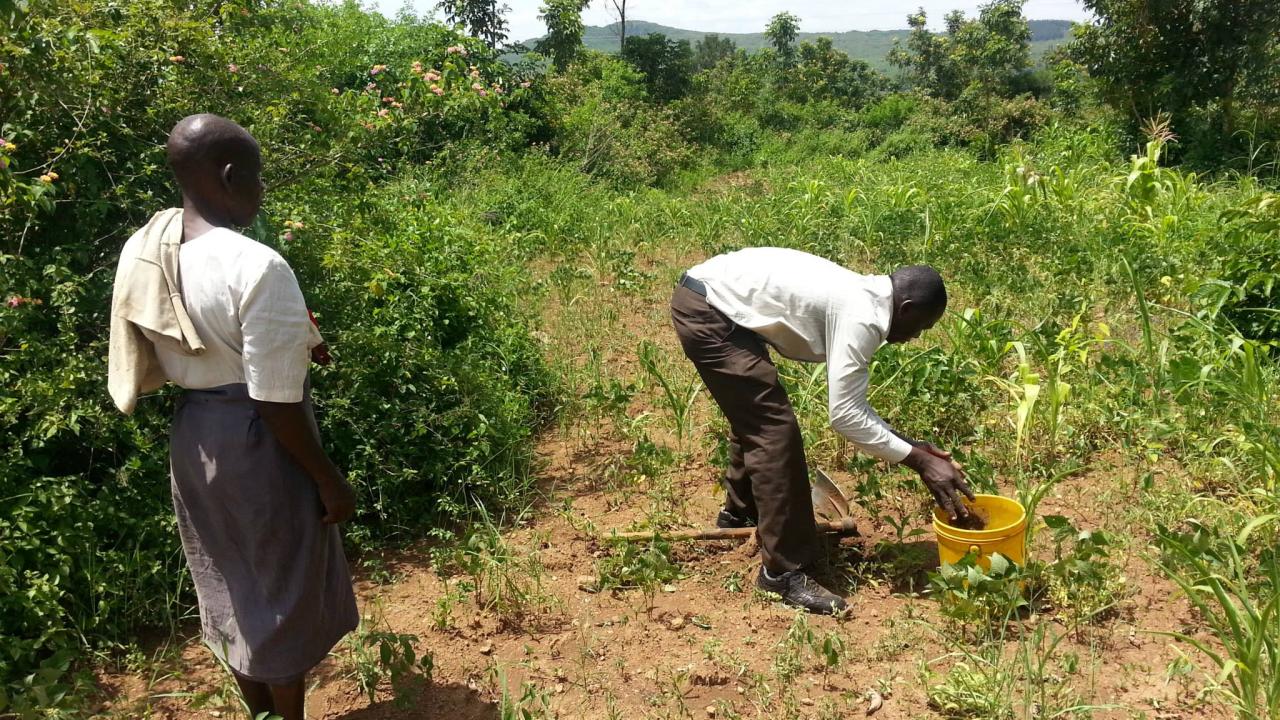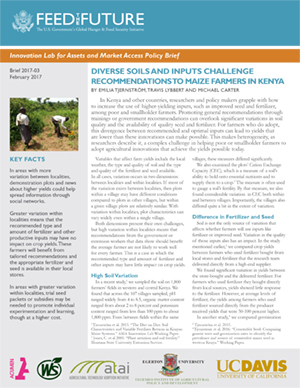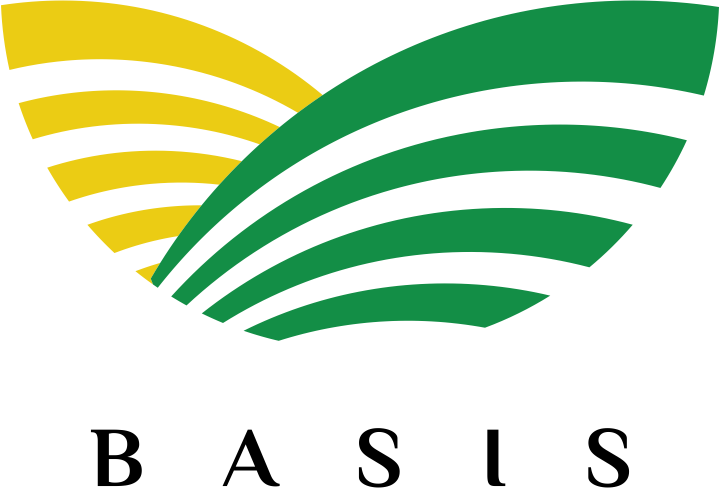
In Kenya and other countries, researchers and policy makers grapple with how to increase the use of higher-yielding inputs, such as improved seed and fertilizer, among poor and smallholder farmers. Promoting general recommendations through trainings or government recommendations can overlook significant variations in soil quality and the availability of quality seed and fertilizer.
For farmers who do adopt, this divergence between recommended and optimal inputs can lead to yields that are lower than these innovations can make possible. This makes heterogeneity, as researchers describe it, a complex challenge in helping poor or smallholder farmers to adopt agricultural innovations that achieve the yields possible today.
Key Facts
- In areas with more variation between localities, demonstration plots and news about higher yields could help spread information through social networks.
- Greater variation within localities means that the recommended type and amount of fertilizer and other productive inputs may have no impact on crop yields. These farmers will benefit from tailored recommendations and the appropriate fertilizer and seed is available in their local stores.
- In areas with greater variation within localities, trial seed packets or subsidies may be needed to promote individual experimentation and learning, though at a higher cost.
 Variables that affect farm yields include the local weather, the type and quality of soil and the type and quality of the fertilizer and seed available. In all cases, variation occurs in two dimensions: between localities and within localities. If most of the variation exists between localities, then plots within a village may have different conditions compared to plots in other villages, but within a given village plots are relatively similar. With variation within localities, plot characteristics can vary widely even within a single village.
Variables that affect farm yields include the local weather, the type and quality of soil and the type and quality of the fertilizer and seed available. In all cases, variation occurs in two dimensions: between localities and within localities. If most of the variation exists between localities, then plots within a village may have different conditions compared to plots in other villages, but within a given village plots are relatively similar. With variation within localities, plot characteristics can vary widely even within a single village.
Both dimensions present their own challenges, but high variation within localities means that recommendations from the government or extension workers that data show should benefit the average farmer are not likely to work well for every farmer. This is a case in which the recommended type and amount of fertilizer and other inputs may have little impact on crop yields.
High Soil Variation
In a recent study,[1] we sampled the soil on 1,800 farmers’ fields in western and central Kenya. We found that across the 107 villages sampled, pH ranged widely from 4 to 8.5, organic matter content ranged from about 2 to 8 percent and potassium content ranged from less than 100 ppm to about 1,800 ppm. Even between fields within the same villages, these measures differed significantly.
We also examined the plots’ Cation Exchange Capacity (CEC), which is a measure of a soil’s ability to hold onto essential nutrients and to supply them to a crop.[2] The measure is often used to gauge a soil’s fertility. By that measure, we also found considerable variation in CEC both within and between villages. Importantly, the villages also differed quite a bit in the extent of variation.
Difference in Fertilizer and Seed
Soil is not the only source of variation that affects whether farmers will use inputs like fertilizer or improved seed. Variation in the quality of those inputs also has an impact. In the study mentioned earlier,[3] we compared crop yields between farmers who used fertilizer bought from local stores and fertilizer that the research team delivered directly from a high-end supplier.
We found significant variation in yields between the store-bought and the delivered fertilizer. For farmers who used fertilizer they bought directly from local sources, yields showed little response to the fertilizer. However, at average levels of fertilizer, the yields among farmers who used fertilizer sourced directly from the producer received yields that were 50-100 percent higher. In another study,[4] we compared germination rates of one seed producer’s hybrid variety that the research team purchased from a sample of local suppliers within a single growing season.
For these locally-purchased seeds, packaging varied in appearance and condition, as did the price and the color of the seeds. Importantly, germination rates varied widely. The average germination rate was 76 percent but in some samples, as few as zero seeds germinated. Kenya’s seed regulations stipulate that 90 percent of basic seed should have no damaged or poor-sprouting seeds. For certified seed, the requirement is 95 percent.[5]
We do not know yet whether the seeds in our sample were of poor quality because they were stored poorly or for long periods of time, both of which can limit their viability. We are currently conducting DNA tests of these samples against seed purchased directly from the producer to see if they were indeed counterfeit.
Learning from Neighbors
A related challenge is what to recommend where farms hover near a fertility threshold where additional fertilizer or other productive inputs could either lead to improved yields or not. A high variation in soil and available inputs even within villages means that farmers are unlikely to learn from their neighbors what will work best for their own plots. In this case, the experience one farmer has with fertilizer and seed will not work well as an example for other farmers who may have a different type and quality of soil.
When farmers learn from each other’s experiences, they might avoid costly and risky experimentation on their own plots with new fertilizer or seed. In a social network-based study,[6] we examined the information passed from farmer to farmer. In some villages, soils varied a lot and in others soils were more similar. In villages where soils were comparable, farmers were willing and able to learn from their neighbors. In villages where soils varied widely, individual farmers experiencing success with a new seed did not translate into a higher likelihood that their friends and neighbors would try that new seed.
Improving Adoption of Innovations
These studies and others show that both environmental and institutional variation can have a significant impact on the opportunities for poor and smallholder farmers in Kenya and other countries. Our results on soil variation shows an opportunity to target improved seed and other interventions based on the variation in soils within a village or larger geographic area. Overall, farmers will benefit from recommendations that are more accurately tailored to their own soil quality and by ensuring that the appropriate fertilizer and seed is available in their local stores.
In areas with more variation between localities, demonstration plots and news about higher yields could help spread information through social networks. In areas with greater variation within localities, trial seed packets or subsidies may be needed to promote individual experimentation and learning, though at a potentially higher cost.
In addition, farmers in areas with high soil variation within localities need tailored recommendations on amendments and fertilizer or the information will likely not be helpful. Other AMA Innovation Lab projects are exploring ways to overcome these challenges. One in Tanzania is testing a portable, on-farm, cost-effective soil testing kit for farmer-specific soil and crop management recommendations. Another in Kenya is testing the impact of personalized soil analysis that allows for optimal input recommendations by agricultural extension workers.
For variation in fertilizer and seed quality, poor storage suggests the need to educate suppliers on appropriate seed handling. Counterfeiting requires policing and verification. Sample packs of fertilizer and seed from reputable sources would provide farmers willing to risk experimenting a chance for higher yields and longer-term success.
Emilia Tjernström is an assistant professor of public affairs and agricultural & applied economics at the University of Wisconsin-Madison.
Travis Lybbert is a professor of agricultural and resource economics at UC Davis.
Michael Carter, a UC Davis professor of agricultural and resource economics, is the director of the Feed the Future Innovation Lab for Assets and Market Access.
[1] Tjernström et al. 2015. “The Dirt on Dirt: Soil Characteristics and Variable Fertilizer Returns in Kenyan Maize Systems.” AMA Innovation Lab Working Paper.
[2] Jones, C. et al 2005. “Plant nutrition and soil fertility.” Montana State University Extension Service.
[3] Tjernström et al. 2015.
[4] Tjernstrom et al. 2016. “Counterfeit Seed: Comparing genetic tests and germination rates to identify the prevalence and source of counterfeit maize seed in western Kenya.” Working Paper.
[5] Kenya Law Review Journal. “Seeds and Plant Varieties (Seeds) Regulations, 1991.” CAP.326 Act Title: Seeds and Plant Varieties (Subsidiary Legislation).
[6] Tjernström. 2016. “Signals, Similarity and Seeds: Social Learning in the Presence of Imperfect Information and Heterogeneity.” Working Paper.
This report is made possible by the generous support of the American people through the United States Agency for International Development (USAID). The contents are the responsibility of the Feed the Future Innovation Lab for Assets and Market Access at UC Davis and do not necessarily reflect the views of USAID or the United States Government.
